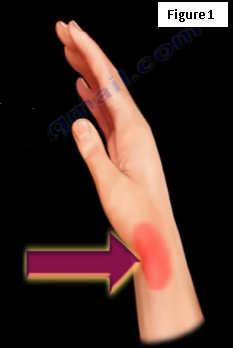
The Finkelstein’s test is used to diagnose the condition of De Quervain syndrome—the stenosing tenosynovitis of the first dorsal compartment of the wrist (Figure 1). The muscles of the first dorsal compartment of the wrist allow for thumb motion. The two tendons that are involved are the abductor pollicis longus and the extensor pollicis brevis. Keep in mind that the extensor pollicis longus is located in the third compartment. (Figure 2)

With De Quervain syndrome, there will be pain and swelling over the radial side of the wrist (thumb side). This condition occurs due to inflammation of the synovial sheath that surrounds the two tendons that control movement of the thumb, thickening, and stenosis of the synovial sheath. A physician will confirm the findings by doing the Finkelstein’s test.
The Finkelstein’s test is conducted by having the patient make a fist with the fingers closed over the thumb and the wrist is bent towards the little finger. An ulnarly directed force is then applied to the wrist to stretch the involved tendons. This is a provocative test that is done to stretch the involved tendons and see if the condition is painful or not. A positive test result is indicated by sharp, local pain over the radial aspect of the wrist.
Some activities that may cause De Quervain Syndrom include:
· Twisting and wringing out wet towels
· Hammering
· Skiing

· Lifting heavy objects
· Caring for young children
o People who care for babies and young children commonly experience De Quervain due to the holding and carrying of the child.
The physician should differentiate between De Quervain Syndrome, Intersection Syndrome, and Wartenberg’s Syndrome. The Finkelstein’s Test is used to diagnose De Quervain syndrome in patients who have pain on the radial side of the wrist.

Intersection Syndrome is not a well-known condition. It is identified when there is pain felt on the top of the forearm where two muscles that connect to the thumb cross over the underlying wrist tendons. The pain is typically located at about 4cm from the wrist joint. The two tendons of the wrist are the extensor carpi radialis longus and the extensor carpi radialis brevis. Pain is increased by the extension and flexion of the wrist—felt more on the top of the forearm. The pain experienced in Intersection syndrome is more proximal than the pain associated with De Quervain syndrome. (Figure 3)

- In Wartenberg’s Syndrome, there is irritation of the superficial branch of the radial nerve. Pain is located at about 8 cm proximal to the radial styloid. The patient will be unable to tolerate wearing a tight bracelet or a wrist watch. The patient will experience pain in addition to numbness, tingling, and paresthesia on the posterior aspect of the thumb. The patient will not complain about weakness. If you tap over the area of the nerve, the patient will have these symptoms, which indicates a positive Tinel’s sign. (Figure 4)
For More Information on Disorders of the Hand, Check out the Links below!:
For More information on Orthopaedic Conditions, check out my YouTube:
Originally published at www.huffingtonpost.com


